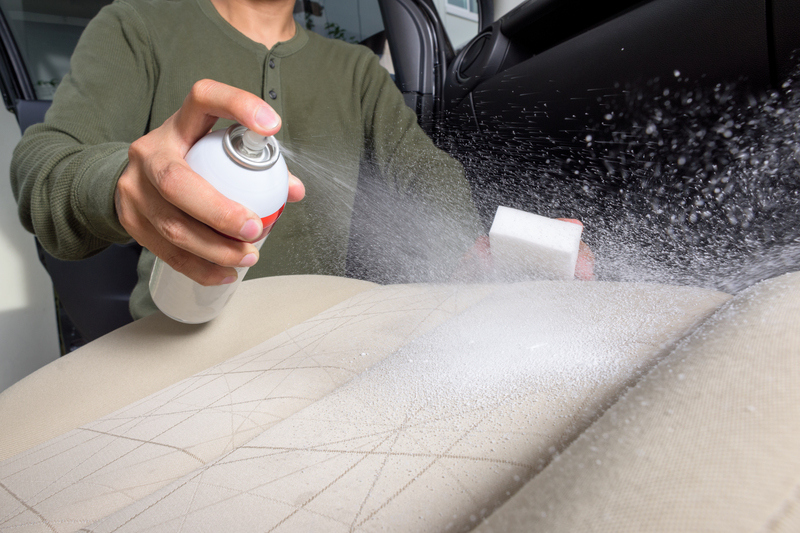The Undeniable Link Between Air Quality and Indoor Well-being
Posted on 31/08/2025
The Undeniable Link Between Air Quality and Indoor Well-being
In today's fast-paced modern world, people spend almost 90% of their time indoors. Whether at home, at work, or in recreational spaces, the air we breathe inside profoundly shapes our health, comfort, and productivity. Yet, many overlook the critical connection between air quality and indoor well-being. In this comprehensive article, we explore the undeniable link between these two essential aspects of daily life, offering actionable insights, solutions, and a deeper understanding of the topic.

Understanding Indoor Air Quality (IAQ): A Silent Influencer
Indoor Air Quality (IAQ) refers to the condition of the air inside and around buildings, especially in relation to the health and comfort of the occupants. Unlike outdoor pollution, indoor air often contains a mix of dust, pollutants, chemicals, and biological contaminants that can't always be seen or smelt, yet can have significant impacts on well-being.
- Volatile Organic Compounds (VOCs): Emitted from paints, cleaning agents, furniture, and building materials.
- Biological Pollutants: Mold, bacteria, pet dander, pollen, and dust mites.
- Particulate Matter: Tiny particles from cooking, smoking, or outdoor pollution that infiltrates indoors.
- Carbon Monoxide and Carbon Dioxide: Emitted from fuel-burning appliances and human respiration.
- Radon: A naturally occurring radioactive gas that can seep through building foundations.
Why Indoor Air Quality Matters More Than Ever
While we often associate pollution with the outdoors, indoor spaces can harbor far worse concentrations of hazardous substances. Factors such as poor ventilation, modern insulation, and the widespread use of synthetic materials mean pollutants can get trapped and accumulate, increasing the risk to occupants.
How Poor Air Quality Impacts Your Health and Comfort
Research has proven a strong, undeniable link between indoor air quality and physical and mental well-being. The effects range from mild discomfort to chronic illnesses, especially for the most vulnerable groups - children, the elderly, and those with existing health conditions.
The Immediate Effects
- Headaches, dizziness, and nausea: Often caused by high VOC exposure or carbon monoxide.
- Fatigue and loss of concentration: High levels of carbon dioxide and poor ventilation lessen oxygen flow to the brain.
- Eye, nose, and throat irritation: Caused by pollutants like VOCs, smoke, or ozone.
Long-Term Health Risks
- Respiratory Diseases: Conditions like asthma, bronchitis, and chronic obstructive pulmonary disease (COPD) are made worse by constant exposure to dust, mold spores, and other airborne irritants.
- Allergies: Persistent exposure to allergens such as pet dander, dust mites, and pollen triggers allergic reactions and rhinitis.
- Cardiovascular Issues: Very fine particulate matter can penetrate the lungs and enter the bloodstream, increasing heart attack and stroke risk.
- Cancer risks: Radon and certain VOCs, such as formaldehyde and benzene, have been directly linked to heightened cancer risk.
Children are particularly vulnerable, as their immune systems are still developing, and they breathe in more air per kilogram of body weight than adults. The elderly or those with chronic illnesses face even greater risks.
Beyond Health: Air Quality and Indoor Comfort
The Impact on Productivity and Cognitive Abilities
Subpar indoor air quality can reduce productivity, focus, and learning capacity. Studies demonstrate that offices and schools with better ventilation and fewer airborne pollutants experience higher test scores and fewer sick days. Employees in spaces with pure, fresh air report greater cognitive function and overall job satisfaction.
Quality of Life and Emotional Well-being
A clean environment elevates mood and alleviates stress. Conversely, living or working in stuffy, contaminated surroundings may lead to irritability, sleep disturbances, and feelings of lethargy.Main Sources of Indoor Air Pollutants
Being aware of where indoor air pollution comes from is the first step toward mitigation. Key sources include:
- Building materials and furnishings: These release formaldehyde, flame retardants, and other chemicals, especially when new.
- Household cleaning and personal care products: Many emit VOCs and other contaminants.
- Cooking and heating appliances: Gas burners and wood stoves release carbon monoxide and particulates into the air.
- Outdoor pollution: Emissions can be brought in through windows, doors, and ventilation systems.
- Pests and pets: Pet dander, dust mites, cockroach debris, and mold thrive in high-humidity environments.
Measuring and Monitoring Indoor Air Quality
To address the link between air quality and indoor well-being, you must first understand and measure your indoor air conditions. Devices and strategies include:
- Air quality monitors: Detect levels of CO2, particulate matter, VOCs, and humidity in real-time.
- Professional IAQ assessments: Certified inspectors can test for mold, radon, and other less obvious threats.
- Humidity sensors: Optimal indoor humidity levels are between 30-50%. Levels above or below this can cause respiratory and comfort issues.
By using these tools, you gain data-driven insight to take targeted action, greatly improving your indoor air and overall well-being.
Effective Strategies for Better Indoor Air Quality
Improving air quality and promoting well-being is achievable with diligent management and the right habits. Below are the main methods for boosting indoor air purity:
Ventilation is Key
- Open windows regularly to circulate fresh air (except on high-pollution or allergy-heavy days).
- Use exhaust fans in kitchens and bathrooms to remove humidity, cooking fumes, and chemical traces.
- Consider a mechanical ventilation system, such as a whole-house air exchanger, especially in new, tightly insulated buildings.
Source Control: Minimizing Indoor Pollutants
- Opt for low-VOC paints and finishes when renovating or decorating.
- Use natural or fragrance-free cleaning agents to limit chemical emissions.
- Ban smoking indoors--tobacco smoke is a potent source of cancer-causing substances.
- Store chemicals and fuels safely, away from living spaces, preferably in a ventilated outbuilding or shed.
Maintaining Optimal Humidity
- Use a dehumidifier in damp areas such as basements to deter mold growth.
- Fix leaks promptly and ensure all rooms are adequately ventilated to keep moisture under control.
Clean and Upgrade Filtration Systems
- Replace HVAC and furnace filters regularly with HEPA-grade alternatives for optimal particle removal.
- Install portable air purifiers that use activated carbon or HEPA filters in problem areas like bedrooms or nurseries.
- Maintain and clean air ducts--buildup of dust or mold inside ductwork can redistribute contaminants throughout the home.
Decorate With Nature: Houseplants and Indoor Greenery
Certain houseplants (such as spider plants, snake plants, and peace lilies) help absorb some airborne toxins and can improve air quality in enclosed spaces, while also beautifying your interior environment.
Emerging Technologies for Indoor Air Quality Management
Rapid advances in technology are providing new tools to maintain a healthy indoor atmosphere:
- Smart air purifiers: Automatically detect air pollutants and adjust filtration levels accordingly.
- Automated ventilation systems: Integrate with home automation platforms for energy efficiency and optimal air exchange.
- Real-time air quality analytics: Apps and analytics platforms provide actionable recommendations to maintain top-notch indoor air quality.
These innovations equip users with unprecedented control over their living and working conditions, making healthier air more accessible than ever.
Special Considerations: Indoor Air Quality in Different Environments
Homes and Apartments
Everyday activities such as cooking, cleaning, and using personal care products generate a host of indoor pollutants. Ensuring regular maintenance, proper ventilation, and mindful selection of household products can make a significant difference in air quality and, by extension, household well-being.
Offices and Commercial Spaces
Modern offices may be energy-efficient but often suffer from poor air exchange. Occupant density, the use of copiers or printers, and HVAC system quality all affect air cleanliness. Companies that prioritize IAQ see reduced absenteeism, higher retention, and greater employee satisfaction.
Schools and Educational Institutions
Children's developing bodies are especially at risk from poor indoor air. Proper ventilation, updated cleaning protocols, and toxin-free building materials are non-negotiable to ensure both learning success and health.
Healthcare Facilities
For the sick and vulnerable, clean air is crucial. Hospitals rely on rigorous air filtration, controlled ventilation, and humidity regulation to protect patients and staff from airborne infections.

Conclusion: Make the Invisible Visible
The crucial connection between air quality and indoor well-being is increasingly clear. From physical health and emotional comfort to productivity and cognitive performance, every aspect of our lives is influenced by the air around us. Recognizing the importance of pure, well-ventilated air indoors is the first step in transforming homes and workplaces into healthier spaces.
Armed with awareness and actionable steps--such as monitoring air quality, improving ventilation, controlling pollution sources, maintaining proper humidity, and leveraging new technologies--you can safeguard your indoor environment. Remember: The air you breathe shapes your future. Make each breath a positive one for your mind, body, and soul.
FAQs: The Link Between Air Quality and Indoor Health
-
How does indoor air quality affect mental health?
Poor air quality can contribute to headaches, fatigue, sleep disturbances, and even depressive symptoms by reducing oxygen supply and increasing exposure to chemicals. -
What are quick ways to improve indoor air right now?
Open windows for cross-ventilation, use houseplants, run an air purifier, and switch to low-toxicity household products. -
How often should I change my air filters?
Every 3-6 months is recommended, but more frequently if you have allergies, pets, or live in a high-dust area. -
Can air pollution enter my home from outside?
Yes--especially through open windows, entryways, and gaps in insulation--so filter outdoor air when air pollution levels are high. -
Are air quality monitors worth it?
Absolutely; they provide real-time feedback and help detect invisible threats, allowing timely intervention for your indoor well-being.
Prioritize your indoor air quality today--it's an investment in your future, comfort, and health. The undeniable link between air purity and indoor well-being is not just a scientific fact; it's a call to action each of us can answer every day.




